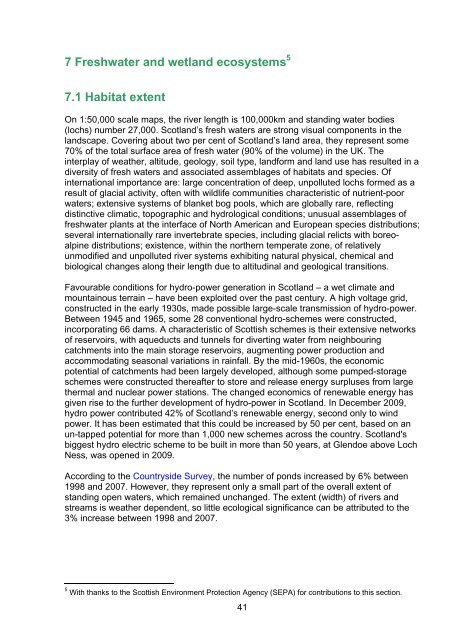Scotland's Wildlife â an assessment of biodiversity in 20
Scotland's Wildlife â an assessment of biodiversity in 20
Scotland's Wildlife â an assessment of biodiversity in 20
You also want an ePaper? Increase the reach of your titles
YUMPU automatically turns print PDFs into web optimized ePapers that Google loves.
7 Freshwater <strong>an</strong>d wetl<strong>an</strong>d ecosystems 5<br />
7.1 Habitat extent<br />
On 1:50,000 scale maps, the river length is 100,000km <strong>an</strong>d st<strong>an</strong>d<strong>in</strong>g water bodies<br />
(lochs) number 27,000. Scotl<strong>an</strong>d’s fresh waters are strong visual components <strong>in</strong> the<br />
l<strong>an</strong>dscape. Cover<strong>in</strong>g about two per cent <strong>of</strong> Scotl<strong>an</strong>d’s l<strong>an</strong>d area, they represent some<br />
70% <strong>of</strong> the total surface area <strong>of</strong> fresh water (90% <strong>of</strong> the volume) <strong>in</strong> the UK. The<br />
<strong>in</strong>terplay <strong>of</strong> weather, altitude, geology, soil type, l<strong>an</strong>dform <strong>an</strong>d l<strong>an</strong>d use has resulted <strong>in</strong> a<br />
diversity <strong>of</strong> fresh waters <strong>an</strong>d associated assemblages <strong>of</strong> habitats <strong>an</strong>d species. Of<br />
<strong>in</strong>ternational import<strong>an</strong>ce are: large concentration <strong>of</strong> deep, unpolluted lochs formed as a<br />
result <strong>of</strong> glacial activity, <strong>of</strong>ten with wildlife communities characteristic <strong>of</strong> nutrient-poor<br />
waters; extensive systems <strong>of</strong> bl<strong>an</strong>ket bog pools, which are globally rare, reflect<strong>in</strong>g<br />
dist<strong>in</strong>ctive climatic, topographic <strong>an</strong>d hydrological conditions; unusual assemblages <strong>of</strong><br />
freshwater pl<strong>an</strong>ts at the <strong>in</strong>terface <strong>of</strong> North Americ<strong>an</strong> <strong>an</strong>d Europe<strong>an</strong> species distributions;<br />
several <strong>in</strong>ternationally rare <strong>in</strong>vertebrate species, <strong>in</strong>clud<strong>in</strong>g glacial relicts with boreoalp<strong>in</strong>e<br />
distributions; existence, with<strong>in</strong> the northern temperate zone, <strong>of</strong> relatively<br />
unmodified <strong>an</strong>d unpolluted river systems exhibit<strong>in</strong>g natural physical, chemical <strong>an</strong>d<br />
biological ch<strong>an</strong>ges along their length due to altitud<strong>in</strong>al <strong>an</strong>d geological tr<strong>an</strong>sitions.<br />
Favourable conditions for hydro-power generation <strong>in</strong> Scotl<strong>an</strong>d – a wet climate <strong>an</strong>d<br />
mounta<strong>in</strong>ous terra<strong>in</strong> – have been exploited over the past century. A high voltage grid,<br />
constructed <strong>in</strong> the early 1930s, made possible large-scale tr<strong>an</strong>smission <strong>of</strong> hydro-power.<br />
Between 1945 <strong>an</strong>d 1965, some 28 conventional hydro-schemes were constructed,<br />
<strong>in</strong>corporat<strong>in</strong>g 66 dams. A characteristic <strong>of</strong> Scottish schemes is their extensive networks<br />
<strong>of</strong> reservoirs, with aqueducts <strong>an</strong>d tunnels for divert<strong>in</strong>g water from neighbour<strong>in</strong>g<br />
catchments <strong>in</strong>to the ma<strong>in</strong> storage reservoirs, augment<strong>in</strong>g power production <strong>an</strong>d<br />
accommodat<strong>in</strong>g seasonal variations <strong>in</strong> ra<strong>in</strong>fall. By the mid-1960s, the economic<br />
potential <strong>of</strong> catchments had been largely developed, although some pumped-storage<br />
schemes were constructed thereafter to store <strong>an</strong>d release energy surpluses from large<br />
thermal <strong>an</strong>d nuclear power stations. The ch<strong>an</strong>ged economics <strong>of</strong> renewable energy has<br />
given rise to the further development <strong>of</strong> hydro-power <strong>in</strong> Scotl<strong>an</strong>d. In December <strong>20</strong>09,<br />
hydro power contributed 42% <strong>of</strong> Scotl<strong>an</strong>d’s renewable energy, second only to w<strong>in</strong>d<br />
power. It has been estimated that this could be <strong>in</strong>creased by 50 per cent, based on <strong>an</strong><br />
un-tapped potential for more th<strong>an</strong> 1,000 new schemes across the country. <strong>Scotl<strong>an</strong>d's</strong><br />
biggest hydro electric scheme to be built <strong>in</strong> more th<strong>an</strong> 50 years, at Glendoe above Loch<br />
Ness, was opened <strong>in</strong> <strong>20</strong>09.<br />
Accord<strong>in</strong>g to the Countryside Survey, the number <strong>of</strong> ponds <strong>in</strong>creased by 6% between<br />
1998 <strong>an</strong>d <strong>20</strong>07. However, they represent only a small part <strong>of</strong> the overall extent <strong>of</strong><br />
st<strong>an</strong>d<strong>in</strong>g open waters, which rema<strong>in</strong>ed unch<strong>an</strong>ged. The extent (width) <strong>of</strong> rivers <strong>an</strong>d<br />
streams is weather dependent, so little ecological signific<strong>an</strong>ce c<strong>an</strong> be attributed to the<br />
3% <strong>in</strong>crease between 1998 <strong>an</strong>d <strong>20</strong>07.<br />
5 With th<strong>an</strong>ks to the Scottish Environment Protection Agency (SEPA) for contributions to this section.<br />
41
















